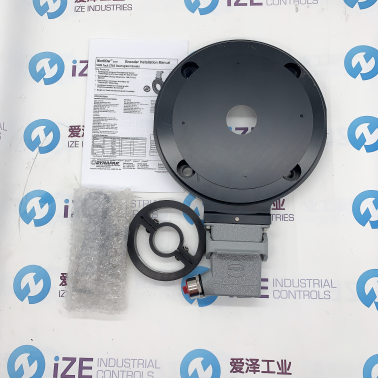对于高要求的工业环境,工程师必须考虑恶劣的环境条件,例如极端温度、高湿度和大量的水。选择高温编码器时需要考虑材料和部件例如编码盘等在高温下的热膨胀以及最高预期温度下的最大运行速度。在指定编码器用于低温时,应考虑由于硬化润滑剂引起的热收缩和额外的启动扭矩。
For high industrial environments, engineers must be account for difficult environmental conditions such as extreme temperatures, high humidity, and large amounts of water. When selecting high temperature encoders need to consider thermal expansion of materials and components such as the encoder disk at high temperatures and the maximum operating speed at the highest expected temperature. When specifying encoders for low temperatures, thermal contraction and additional starting torque due to hardened lubricants should be considered.
温度对编码器性能的影响 Effects of Temperature on Encoder Performance 在光学编码器中,码盘在LED和光电探测器之间通过,调制光束以生成脉冲流,该脉冲流可被处理以产生速度、方向或位置。光学编码器使用由玻璃、聚酯薄膜或金属制成的码盘。磁性编码器的工作原理类似,但使用的是磁性材料在磁畴范围内。在这两种情况下,极端温度和湿度都会影响性能、机械性能和使用寿命。 高温下的热膨胀是个问题。在光学编码器中,码盘和源/检测器之间的气隙可以窄至0.020”。根据温度、间隙的大小、材料的热膨胀系数(CTE)和方向,这种膨胀可能会使组件相互接触,从而造成损坏甚至灾难性故障。 极端温度也会损坏码盘本身。高温会使聚酯薄膜变色,导致信号失真。极端条件会使码盘本身变形。热量还会使轴承、润滑剂和密封件退化,导致整机的早期故障。 在采矿、石油和天然气以及野外应用中发现的低温会带来一系列不同的问题。热收缩会使光学编码器的码盘变形,影响信号质量并可能引入异常。轴承和润滑可能会成为一个问题。润滑油在低温下会变硬。如果编码器一直处于闲置状态,则启动时润滑剂不会均匀分布在轴承周围。由于滚动体与轴承内圈或外圈之间的摩擦,这种情况可能导致轴承部件损坏。润滑剂的稠度也会大大增加启动扭矩。 以上,我们一直在谈论的是光学编码器。极端温度同样也会影响磁性编码器,但影响程度较小。磁轮的膨胀和收缩可以改变磁极的间距,从而改变输出。气隙不是问题。通常,现代磁性编码器具有较宽的气隙(高达 0.070”),并且由于热膨胀或收缩引起的任何变化都在可行的气隙公差范围内。 In an optical encoder, a code disk passes between an LED and a photodetector, modulating the beam to generate either a pulse stream that can be processed to yield speed, direction and/or position. Optical encoders use code disks made of glass, Mylar, or metal. Magnetic encoders operate on a similar principle, but use wheels patterned with magnetic domains. In both cases, extreme temperatures and moisture can impact performance, mechanical properties, and lifetime. Thermal expansion at high temperatures is a problem. In optical encoders, the air gap between the disk and the source/detector can be as narrow as 0.020”. Depending on the temperature, the size of the gap, the coefficients of thermal expansion (CTEs) of the materials, and the orientation, this expansion could bring the components in contact with one another, causing damage or even catastrophic failure. Extreme temperatures can also damage the discs themselves. High temperatures can discolor Mylar, introducing signal distortion. Extreme conditions can distort the disk itself. Heat can also degrade bearings, lubricants, and seals, leading to early failure of the overall unit. Low temperatures such as those found in mining, oil and gas, and off-road applications, present a different set of issues. Thermal contraction can distort the code disk of an optical encoder, affecting signal quality and potentially introducing anomalies. Bearings and lubrication can become a problem. Lubricants harden at low temperatures. If the encoder has been sitting idle, then the lubricant will not be evenly distributed around the bearings at startup. This situation could result in damage to the components of the bearing, due to friction between the rolling elements and inner or outer race of the bearings. The consistency of the lubricant can also substantially increase starting torque. Thus far, we have focused on optical encoders. Thermal extremes also affect magnetic encoders, although to a lesser degree. Expansion and contraction of the magnetic wheel can alter the pitch of the magnetic poles, altering the output. Air gaps are less of an issue. Typically, modern magnetic encoders a have wide air gaps (up to 0.070”) and any variation caused due to thermal expansion or contraction are within the tolerance range of workable airgap. 如何选择适用于极端温度的编码器 How to Choose an Encoder for Extreme Temperatures 所有这些因素使得在指定编码器时必须考虑温度。请注意,超过推荐的编码器速度会降低其热容差。考虑额定温度为-40°C至85°C,建议最高转速为3000转/分的编码器。每超过1000转,温度通常需降低10°C。 确保制造商已使用高加速寿命测试(HALT)对设备进行了认证。这包括设计在受到热冲击(温度的快速和大范围波动)以及振动时的性能。这些条件对于玻璃代码盘等易碎组件来说可能是一个特殊的问题。 应用程序的性能需求也可能发挥作用。磁盘质量和分辨率之间存在权衡。玻璃和金属码盘有限制。最高分辨率的编码器使用Mylar码盘,它更容易受到极端温度的影响。不要认为分辨率越高就越好。编码器只能报告位置,它们不能补偿系统中的机械误差。指定分辨率时,请务必选择实际有利于应用场合的级别。 All of these factors make it essential to take temperature into account when specifying an encoder. Be aware that exceeding the recommended speed of an encoder will decrease its thermal tolerance. Consider an encoder rated for -40°C to 85°C with a recommended top speed of 3000 RPM. For every 1000 RPM above that speed, the temperature is typically de-rated by 10. Make sure the manufacturer has qualified the unit using highly accelerated lifetime testing (HALT). This includes the performance of the design when exposed to thermal shock (rapid and wide swings of temperature) along with vibrations. These conditions can be a particular problem for fragile components like glass code disks. The performance demands of the application may also come into play. There is a trade-off between the quality of the disk and resolution. Glass and metal code disks are limited. The highest resolution encoders use Mylar code disks, which are more susceptible to temperature extremes. Don’t assume that higher resolution is necessarily better. Encoders can only report position, they cannot compensate for mechanical errors in the system. When specifying resolution, be sure to select a level that will actually benefit the application. 湿度对编码器性能的影响 Effects of Humidity on Encoder Performance 水分是一系列应用中的问题,包括海洋环境、造纸等工业制造以及制药和食品制备等冲洗环境。湿度会降低光学表面的性能,从而衰减光学编码器中的信号。它还会损坏电子设备,导致早期故障。这是腐蚀性环境中的一个特殊问题,例如海洋环境或那些涉及刺激性化学品的环境。对于这些应用,OEM最好选择具有防护等级(IP)评级的组件。 IP级组件专门设计用于承受所列条件。例如,IP64组件防尘并且可以承受低压水喷射,而IP66组件可以处理高压水射流,而IP67装置可以防止浸入指定深度。特殊措施包括封装电子设备、轴承上复杂的密封设计、密封件和润滑剂的替代材料以及特殊外壳。 根据分辨率和性能要求,磁性编码器可能是更好的解决方案。磁性编码器不受湿气影响。它们可以在潮湿的环境中工作,甚至可以完全浸泡在液体中。 在寻找编码器之前先研究您的应用条件。了解IP评级系统以选择能够提供所需使用寿命周期的设备。以确保设备经过适当的认证并发现任何特殊的安装要求。 对于最极端的环境,最好的反馈选择可能是解析器。这些设备不包含任何板载电子设备。它们在最恶劣的条件下表现良好。 Moisture is a problem in a range of applications including marine environments, industrial manufacturing such as papermaking, and washdown environments like those found in pharmaceutical manufacturing and food preparation. Humidity can degrade optical surfaces to attenuate the signal in optical encoders. It also damages electronics, leading to early failure. This is a particular problem in corrosive environments such as marine environments or those involving harsh chemicals. For these applications, OEMs are best off choosing components with ingress protection (IP) ratings. IP-rated components are designed specifically to survive the conditions listed. IP64 units, for example, are dust tight and can tolerate low pressure water spray, while IP66 components can handle high-pressure water jets, and IP67 units can protect against immersion up to a specified depth. Special measures include encapsulated electronics, sophisticated seal designs on the bearings, alternative materials for seals and lubricants, and specialty housings. Depending on the resolution and performance requirements, a magnetic encoder may be a better solution. Magnetic encoders are not impaired by moisture. They can operate in humid environments and even totally immerse in liquid. Study the conditions of your application before looking for an encoder. Understand the IP rating system to choose a device that will provide the lifetime required. Talk to your vendor to ensure that the devices have been properly qualified and discover any specialty mounting requirements. For the most extreme environments, the best feedback option may be a resolver. These devices do not contain any onboard electronics. 声明: - 文章转载自DYNAPAR,由爱泽工业翻译,如有侵权,请联系删除! - 如有偏颇,欢迎指正!

上一篇:关于工业电机风机的安全规格介绍
下一篇:工业活性炭应用场合

 沪公网安备31011002006738号
沪公网安备31011002006738号

